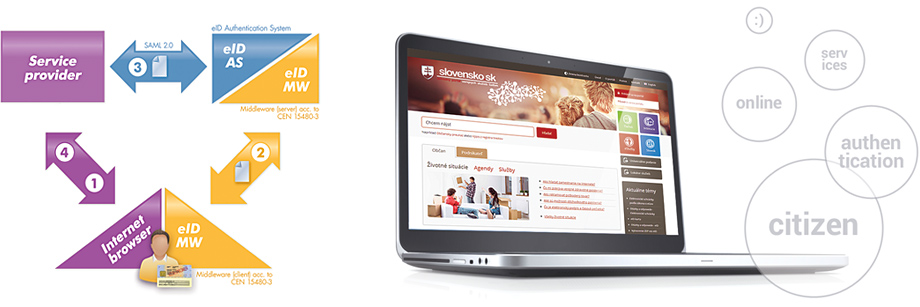 eID Identity Access Management
eID Identity Access Management
 The eID Identity Access Management enables the providers of electronic services to use the eID card for secure and unambiguous identification and authentication of the citizens. The IdP’s functionality is provided via standard interfaces like SAML 2.0 and BSI TR-03130 (eID server) allowing the registered service providers to integrate the eID authentication to their services using standard components.
The eID Identity Access Management enables the providers of electronic services to use the eID card for secure and unambiguous identification and authentication of the citizens. The IdP’s functionality is provided via standard interfaces like SAML 2.0 and BSI TR-03130 (eID server) allowing the registered service providers to integrate the eID authentication to their services using standard components.
The concept of the eID authentication fulfills the requirements of the EU data protection law (95/46/EC) and the recommendations of the European Network and Information Security Agency (ENISA), where the disclosure of personal data is limited by the eID chip to the disclosure of only personal data required for a specific purpose. The access to the personal data must also be confirmed by the citizen by entering the eID PIN.

Key Features
- Identification and authentication of citizens based on EAC protocol (acc. to BSI TR-03110):
- QAA Level 4 Authentication
- Privacy Protection, Selective Data Disclosure
- Non traceability
- Standard interfaces:
- OASIS SAML 2.0
- BSI TR-03130 (eID server)
- Standard architecture:
- ISO 24727-2,3,4
- CEN 15480-3
- eID Client available for Windows, Linux and Mac OS X
- Works with all internet browsers
Main Benefits
- Secure identification and authentication of the citizens in electronic communication
- eID authentication functionality provided as a service (by one or more eID Identity Providers)
- The providers of electronic services may start using eID authentication just by integrating to the eID IdP
- The eID authentication of the citizen’s may be easily integrated into the European Cross Border Authentication Platform (STORK)
- Available to the major of the users (multiplatform client, all browsers supported)
Download pdf
 The eID Identity Access Management enables the providers of electronic services to use the eID card for secure and unambiguous identification and authentication of the citizens. The IdP’s functionality is provided via standard interfaces like SAML 2.0 and BSI TR-03130 (eID server) allowing the registered service providers to integrate the eID authentication to their services using standard components.
The eID Identity Access Management enables the providers of electronic services to use the eID card for secure and unambiguous identification and authentication of the citizens. The IdP’s functionality is provided via standard interfaces like SAML 2.0 and BSI TR-03130 (eID server) allowing the registered service providers to integrate the eID authentication to their services using standard components.